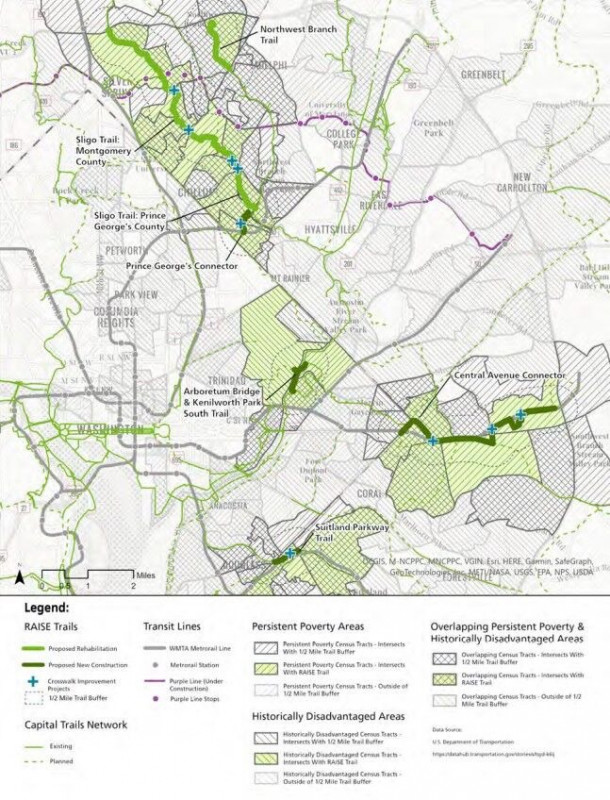Improvements coming to Maryland and DC multi-use trails

Anacostia Riverwalk Trail near Pennsylvania Avenue SE by deckerme licensed under Creative Commons.
Six local trails for walking and biking across Montgomery and Prince George’s Counties in Maryland and in Washington, DC, will see improvements over the next few years through the rehabilitation of some of the region’s oldest trails and the construction of new trail segments.
The trail projects will build the Arboretum Bridge to help complete the Anacostia Riverwalk Trail, rehabilitate Sligo Creek Trail and Northwest Branch Trail, and support construction of the Central Avenue Connector Trail, Suitland Parkway Trail, and Prince George’s County Connector.
Map of proposed trail infrastructure improvements. Image by the Capital Trails Coalition 
The trail projects will close gaps, rehabilitate and upgrade substandard facilities, increase carrying capacity, enhance safety, improve access for people with physical disabilities, and expand access to the Capital Trails Network for underserved communities. In total, the projects include 15 miles of new construction and rehabilitation with safety improvements at major intersections and at-grade crossings.
The new trail segments add nine safe connections to Metro and passenger rail stations, including four new connections to Metrorail Green and Blue Line stations and are in close proximity to three future Purple Line light rail stations. They provide access for more than 600,000 residents within a mile and a half of the trails and active, sustainable commuting options to the 53,000 workers that are within a half-mile of the trails.
The grant requires agencies to stick to a relatively short timeline to complete infrastructure projects: all of the grant funding must be obligated on a contract by September 2027 and expended by September 2032, which means we should see improvements and construction within the next few years.
These changes are made possible through the recent award of a $25 million US Department of Transportation (USDOT) RAISE grant to a regional partnership between Prince George’s County Office of the County Executive, Maryland-National Capital Park and Planning Commission (Prince George’s County Department of Parks & Recreation and Montgomery Parks), and the District Department of Transportation (DDOT) to build out the regional Capital Trails Coalition multi-use trail network.
Why this matters
In addition to creating more and improved facilities for recreation and for transportation day-to-day, these trail projects will have a broader impact on the region through:
Improved equitable access to trails: Each trail project is located completely within Areas of Persistent Poverty and/or Historically Disadvantaged Communities, as defined by USDOT, and will directly improve outcomes for traditionally underserved populations across the region. Forty impoverished census tracts in Prince George’s and Montgomery Counties in Maryland and the District of Columbia will benefit from the trail projects.
Improved safety for people using trails: The projects include safer connections to nine rail stations, including four new trail connections to Metrorail Green and Blue Line stations, enabling and encouraging more multimodal transportation. The projects will create connections across our communities by bridging the Anacostia River, creating a new connection between DC’s Wards 5 and 7, and implementing safety improvements at nine major intersections and at-grade trail crossings.
A powerful vision of a regional trails network: The regional approach to trails demonstrates system-level, cross-jurisdictional thinking that makes these types of trail projects more competitive for grants and draws more political support.
Financial impacts of an improved trail network. 
Economic, health, and environmental impacts on the region: A study to quantify the impact of the Capital Trails Coalition showed that, when the entire trail network is completed, the trail network is expected to produce $1.02 billion in total economic impacts per year, as well as $2.4 billion in savings per year generated through the impacts of public health savings, new jobs created, and environmental impacts.
More about the RAISE Grant
This federal grant catalyzes the dollars needed to match and completely fund these trail projects. The $25 million grant award comprises about a third (34%) of the $73 million total cost of the project portfolio. It leverages nearly $40 million in state and local commitments that represent the eligible matching funds for the grant, in addition to more than $9 million in other federal funds.
Creating a world-class network of regional trails, as outlined by the Capital Trails Network, has required local leaders, transportation and recreation agencies, and other stakeholders to plan years ahead and stay dedicated to each trail project from ideation, to planning, design, and construction. The process of making even a single trail segment a reality often takes many years, and too often can take decades. Despite total project budgets in the hundred thousands to millions of dollars, these infrastructure projects cost a fraction of other capital expenditures and they produce strong economic, health, and environmental impacts for the region year after year.
Securing large and/or regional grants like this one takes time, dedicated and knowledgeable staff, and technical capabilities. They require specialized technical expertise, strategy, coordination, and administrative work. Individual jurisdictions may not have the time or expertise to be successful on their own so creating a collaborative approach can help fill any gaps.
This grant funding was only possible through the significant efforts of many different organizations, including several individuals who led efforts within their agencies, whether to secure funding to match the federal grant, to conduct technical assessments, or to build political support.
—-
This post was authored by staff at the Capital Trails Coalition, which exists to advance the vision of creating a world-class, equitably distributed regional network of multi-use trails for people of all ages and abilities - just like the project you are reading about here.
